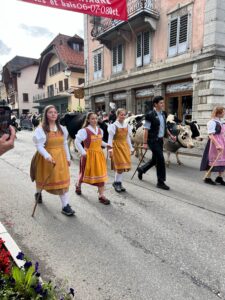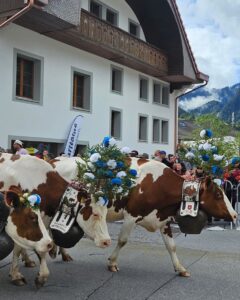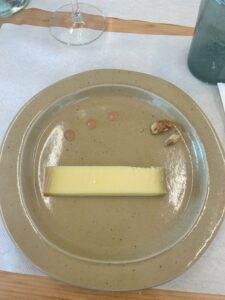This past September, Oldways brought a group of food lovers to Switzerland-a land of towering landscapes, gorgeous cities, towns and villages, amazing wines and chocolates, and of course, spectacular Alpine cheeses. We explored from Zurich to Gruyère to Bern, and back to Zurich, with plenty of stops in between admiring all that is delicious and interesting about Swiss food, culture and history.

One of the highlights was learning about Le Gruyère AOP and experiencing firsthand the production of this award-winning cheese-a tradition that has been passed down since the year 1115.
Every detail in this process matters-from the care provided to the animals by local farmers to the skilled hands of passionate cheesemakers. Join us as we recap our trip and reminisce on the amazing moments that we were lucky to experience.
Starting at the farms with the milk
The complex flavors of Le Gruyère AOP start with the cows, whose raw milk makes the cheese’s flavor profile unique.
Alpine-style cheeses, like Le Gruyère AOP, are produced in mountainous regions. As the snow melts and retreats in the summer, melting ice from the peaks of the Swiss Alps nourishes the pastures where the cows graze. The herds graze higher, feasting on rich pastures of grass, wild herbs, and flowers that result from the local air, soil, water, and mountain topography. Because of this, the high-quality milk has a signature nutty, grassy flavor.
Le Gruyère AOP is a raw milk cheese-meaning that it is produced with milk that has not been pasteurized or heat-treated above the body temperature of the animal before the addition of rennet, an important enzyme used in the production of cheesemaking. Heat treatment, including pasteurization, removes most of the bacteria, yeasts, and other microorganisms that make a cheese unique. “Pasteurization is the application of mild heat to foods to facilitate the destruction of microorganisms.” (The Oxford Companion to Cheese, pg. 544).

While there are delicious heat-treated and pasteurized cheeses, raw milk cheeses are worth celebrating for their complexity of flavor, diversity of microflora, and history. The quality of the ingredients, the extreme care taken by producers, and the natural cheese aging process ensure that raw milk cheeses are a safe choice.
We had the opportunity to meet with a local farmer and milk producer, Pascal Surchat, who graciously welcomed us to his farm, showed us around his property, introduced us to his cows, and let us taste some cheese that was produced with their milk. His pride and dedication to his work was evident.
Production
We also had the incredible opportunity to visit with René Pernet of la Fromagerie du Haut-Jorat to see the production of Le Gruyère AOP. We saw the copper vats famous for Le Gruyère AOP creation, and witnessed the cheesemakers cutting the curd and testing the texture by hand. René showed us the round molds that shape the cheese into wheels, the salt bath, or brine that the wheels sit in for 24 hours after coming out of the molds, and then the cheesemaker’s cellar where the wheels stay for three months as they begin their maturation process.
Aging
After three months, the wheels leave the dairy to age on wooden boards in caves d’affinage, or maturing cellars. So, we headed to Fromco to check this out.
The experience was amazing. The cool, humid cellars were filled with what seemed like never-ending rows of big wheels of Le Gruyère, and the air smelled strongly of ammonia-the result of the wheels aging.
This type of environment is key for proper aging. But the cheese doesn’t just sit untouched…Cheesemakers pay close attention to the wheels even during the maturation phase-turning them and brushing them with salt water.
The affinage lasts between five to 18 months. However, according to Le Gruyère AOP’s offcial website, “At four months, the wheels are checked and taxed by experts of the Interprofession du Gruyère association, according to very precise and rigorous criteria. They can display the name Le Gruyère AOP only after this taxation. As always, quality is the key word. As soon as they reach five months, the wheels are put on the market by the affineur (maturer).”=
At this point, the cheese is exported around the world for people to enjoy!
Celebration 
The hard work does not go unrecognized-animals and farmers who sustain Switzerland are highly respected and celebrated. One example of this is La Désalpe-a traditional Swiss festival that celebrates the Alpine cows and the changing of the seasons.
After more than four months of grazing in Alpine pastures, the cows make their way down to the plain and are honored-bedecked in bells, and gorgeous flower crowns. The families that tend to the herds proudly parade with them through the streets. It is a celebration steeped in Swiss culture and tradition.  Being there in person was a real “pinch-me” moment!
Being there in person was a real “pinch-me” moment!
Experience this journey from your own home
Even if you might not have the time or resources to travel all the way to Switzerland, you can still indulge in the authentic flavors of this world-renowned cheese from the comfort of your own home! Its unique nutty, fruity, and slightly sweet flavor will transport your taste buds straight to the Swiss Alps.
 The commitment to quality and authenticity is evident at every stage of the process, ensuring that the cheese you enjoy is of the highest standard. From the first bite, you can taste the care and attention that has gone into crafting this delicious cheese.
The commitment to quality and authenticity is evident at every stage of the process, ensuring that the cheese you enjoy is of the highest standard. From the first bite, you can taste the care and attention that has gone into crafting this delicious cheese.
So, the next time you savor a slice of Le Gruyère AOP cheese, take a moment to appreciate the journey that has brought it to your plate. It’s a journey that is steeped in tradition, history, love and respect for the land.
A special thank you to all of the wonderful people that made this trip so amazing!










